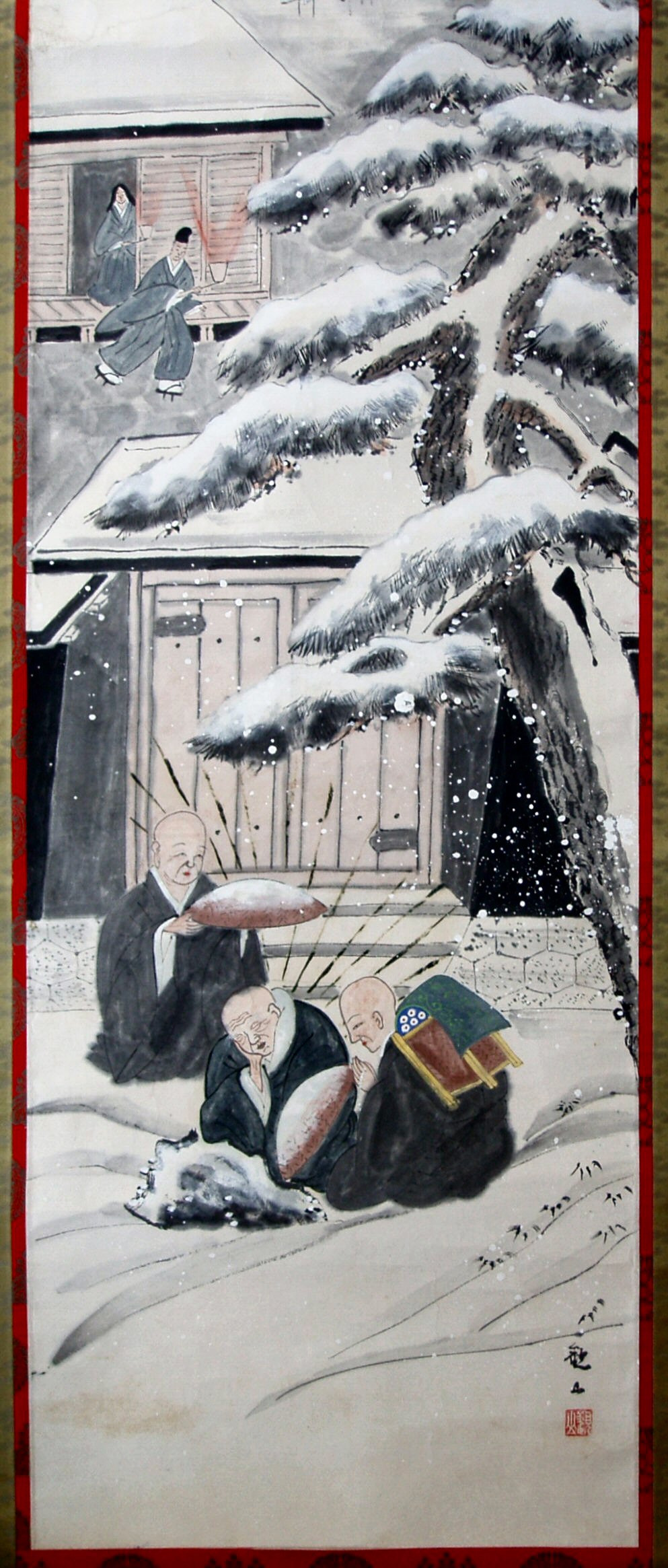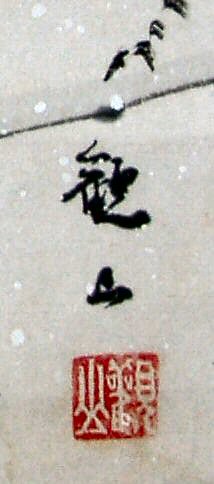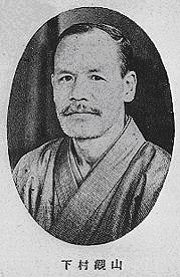



Japanese Painting "Stone Pillow" by Contemporary Master Kanzan Shimomura (1873-1930)
當代日本畫大師下村觀山(1873---1930)作 "石枕之圖"
下村觀山(1873---1930)
生於和歌山縣。東京美術學校第一期學生,師從狩野芳崖、橋本雅邦。在校不僅學習了狩野派,而且通過古畫研究還掌握了大和繪畫技法,深得岡倉天心垂青,畢業後留校直接任副教授,與橫山大觀、菱田春草作為日本美術院的中心人物,在明治時期,即把創作新的日本畫作為奮鬥目標。也就在此時,觀山確立了研究古典、筆法獨特、高雅穩健的個人畫風。1917年45歲 的他,成了帝室技藝員。功成名就的觀山和過去一樣,並未留下重要的文物級的傑作,並於晚年開始傾心于古畫,並開始嚼酒,過著 與世隔絕,畫仙似的生活。寒空這幅畫就是畫家以獨特的筆法,只以鳥的鳴叫與振翅聲向人們述說著廣裘空間的靜謐。在此我們可以清楚地看到 他對以表現靜謐著稱的、並被他崇尚為東洋畫最高境界的宋和元代古畫的憧憬以及自然直觀的心境。
與橫山、菱田等革新派相比,他屬穩健派,傳統功力扎實,也較為保守,以卓越的技巧得名一時。為弘揚漢畫、大和畫、琳派等技法,創作了一些高品味的、色彩豔麗的作品。代表作《林間之秋》(1907)巧妙融入了尾形光琳的裝飾手法。1914年他又與橫山大觀繼承天心遺志再興日本美術院。後期作品如《白狐》(1914)、《弱法師》(1915)。

Kanzan Shimomura (下村観山, Shimomura Kanzan, April 10, 1873 – May 10, 1930) was the pseudonym of a nihonga painter in Meiji through to the early Shōwa period Japan. His real name was Shimomura Seizaburō.
Kanzan was born in 1873 in Wakayama city, Wakayama prefecture into a family of hereditary Noh actors.
Having moved to Tokyo at the age of eight, Kanzan studied under Kanō Hōgai, and after Hōgai's death, under Hashimoto Gahō. He graduated first in his class at the Tokyo Bijutsu Gakkō (the forerunner of the Tokyo National University of Fine Arts and Music), and became a teacher at the same institution in 1894.
When Okakura Tenshin left government service to establish the Japan Fine Arts Academy (Nihon Bijutsuin), Kanzan joined him, together with Yokoyama Taikan and Hishida Shunso. However, Kanzan returned to his teaching post at the Tokyo Bijutsu Gakko from 1901-1908, with a hiatus from 1903-1905, when he went to study in England.
From 1914, he helped reestablish the Japan Fine Arts Academy, and in 1917 was appointed a court painter to the Imperial Household Agency. He served as a judge for both the Bunten and the Inten Exhibitions.
In terms of style, Kanzan was influenced by the Rimpa and the Kano schools, as well as early Buddhist paintings and Tosa school emaki. To these elements, he combined the realism developed from his exposure to western art works during his stay in England.
One of his representative works is a byōbu titled Yoroboshi or "The Beggar Monk" was created in 1915 in colored ink and gold leaf on paper. It is currently housed in the Tokyo National Museum, and is registered as an Important Cultural Property by the Agency for Cultural Affairs. The screen depicts a scene from a famous Noh play of the same name. In the scene, blind monk, has been falsely accused of a crime. Disowned by his family he wanders about, living as a vagrant. Although he is now blind, he has become one with the universe and can see all that surrounds him. Kanzan borrowed heavily from Momoyama period and Edo period style and composition, and the work shows a strong Rimpa influence.
Notable works
* 光明皇后 (1897, Imperial Household Agency)
* 修羅道 (1900, Tokyo National Museum)
* 鵜鴎図 (1901, Museum of Modern Art, Shiga)
* ダイオゼニス ("Diogenes", 1903, Tokyo National Museum of Modern Art)
* 木の間の秋 (1907, Tokyo National Museum of Modern Art, Important Cultural Property)
Yoroboshi
* 大原御幸 (1908, Tokyo National Museum of Modern Art)
* 鵜図屏風 (1912, Tokyo National Museum)
* 白狐 (1914, Tokyo National Museum)
* 弱法師 (1915, Tokyo National Museum, Important Cultural Property)
* 春雨 (1916, Tokyo National Museum)
* 楠公 (1921, Tokyo National Museum)
* 景雲餘彩 (1922, Imperial Household Agency)
Click Here to See Other Japanese Paintings
Click Here to See Other Paintings
Click Here to Go Back to Homepage